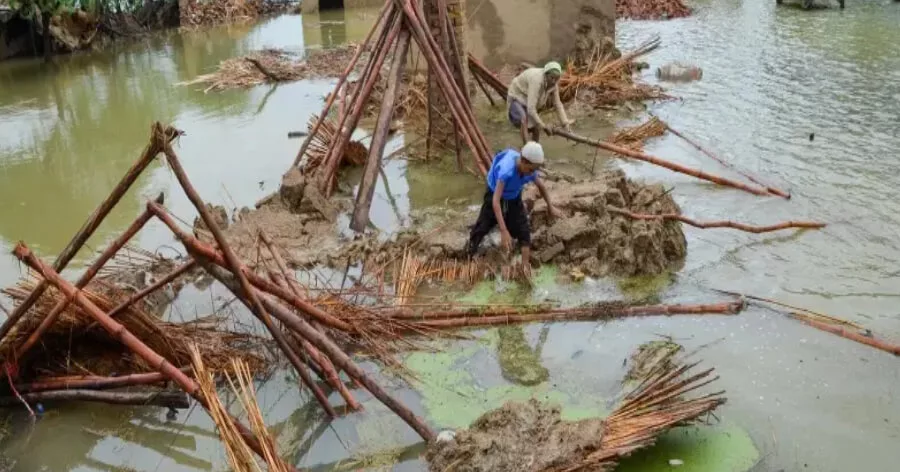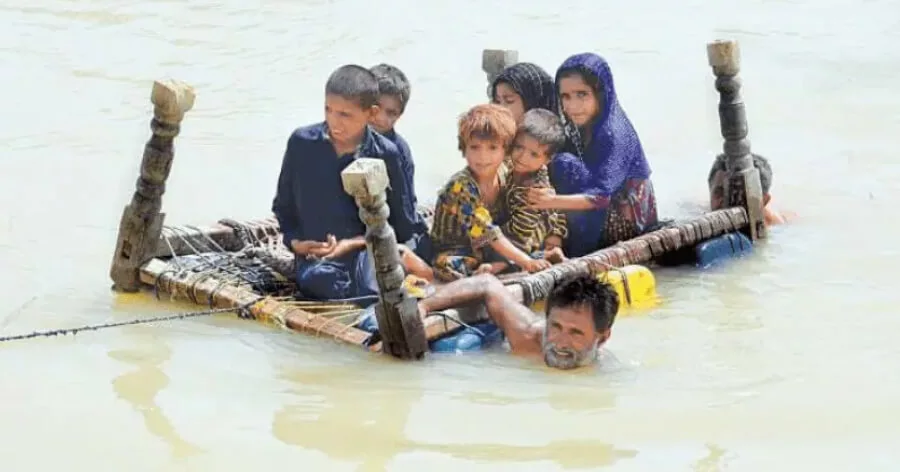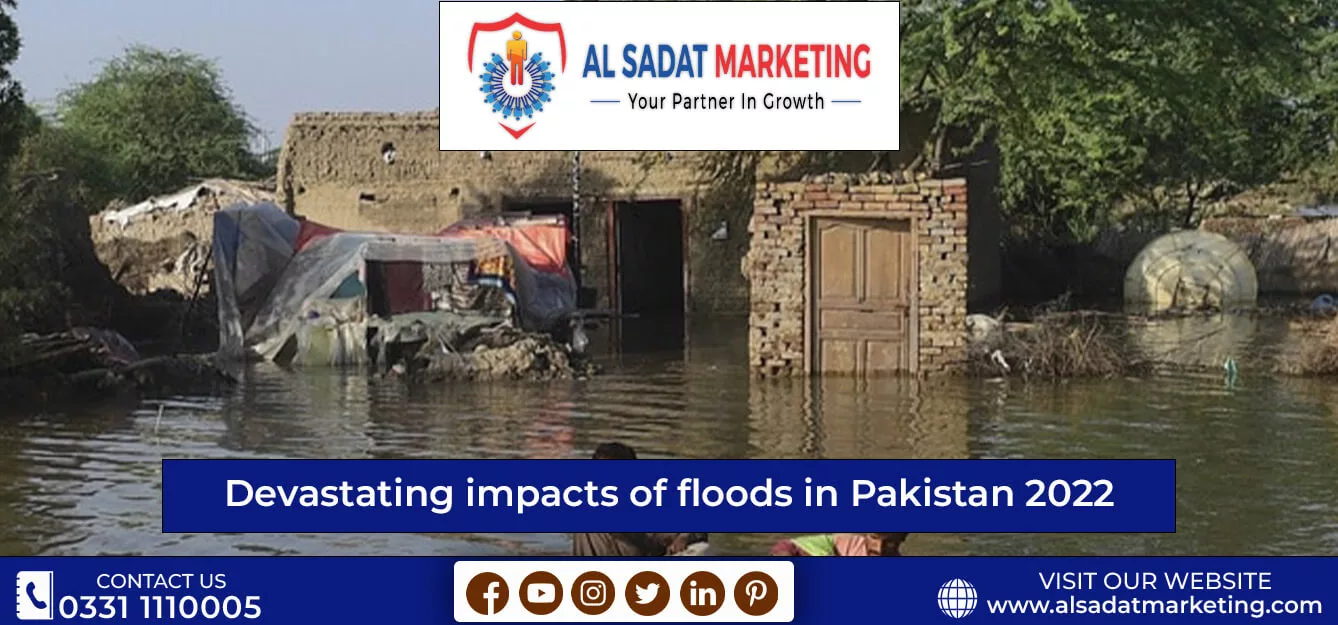Devastating Impacts of Floods in Pakistan 2022

Roads, homes, schools, and hospitals have all been destroyed by violent swells across most of Pakistan. Millions of people were forced from their homes and struggled to reach islands of safety through waist-deep, foul water. The destruction to almost all of the nation’s crops, thousands of animals, and reserves of wheat and fertilizer has sparked worries of an impending food catastrophe.
The Pakistani government and international relief organizations have scurried to save people and crucial infrastructure in what officials have called a climate disaster of epic proportions since a deluge of monsoon rains lashed Pakistan last week, piling more water on top of more than two months of record flooding that have killed hundreds of people and displaced tens of millions.
With additional rain expected in the coming weeks, around a third of the country, including its agricultural belt, is currently under water. According to the nation’s planning minister, Ahsan Iqbal, the damage caused by the flood would probably be “much more” than the early estimates of about $10 billion.
Impacts of Floods in Pakistan 2022
Experts caution that the harm to the nation’s agriculture industry may have global repercussions. One of the biggest producers and exporters of rice and cotton in the world, both of which were severely damaged by the flood, is Pakistan. A blow to global cotton production in a year when cotton prices have skyrocketed as other major producers from the United States to China have been plagued by extreme weather, officials said that up to half of the country’s cotton crop has been damaged.
The fall wheat growing season in Pakistan is also in danger of being derailed by the flooding, which might result in continuing food shortages and price increases into the next year. At a time when the world’s wheat supplies are uncertain, it is a concerning outlook for a nation that depends on its wheat production to feed itself.
According to the United Nations, more than 1,300 people have died in floods in Pakistan since the start of the monsoon season this summer, with children making up nearly half of those who perished. Additionally, more than 6,000 people have been hurt. There have been almost 33 million displaced persons. With additional floods anticipated in the upcoming weeks, floodwater currently covers an area greater than the size of Britain, or around 100,000 square miles.

The Sindh Province has been among the hardest hit by the rains, producing around a third of the nation’s food supply. This monsoon season, the province got about six times as much rain as it had in the previous 30 years, which, according to the U.N. Food and Agriculture Organization, devastated about 50 percent of the area’s crops.
Imdad Hingorja, a 45-year-old farmer, had a little plot of land in Sanghar, one of Sindh’s most important cotton-producing regions, and he was cultivating cotton there. He claimed that the rains and floods struck just when his fields’ crops were ready for harvest.
The ongoing melting of Pakistan’s 7,000 glaciers has intensified the impact of the monsoon rains. The nation is home to the majority of glacial ice outside of the polar caps. Recent heat waves and climate change have caused multiple glacial-outburst floods. In the mountainous north of the country, meltwater and rain have combined to make hillsides into streams.

The destruction has been terrible for the tens of thousands of smaller landowners and farmers that make up the backbone of Pakistan’s agriculture sector, even if it is likely that major landowners will survive the floods.
In Pakistan, where massive estates are cultivated by farmers compelled to serve as slaves for debt, the system of land ownership is still incredibly feudal.
Aid workers have warned that rural populations may still experience a second wave of mortality due to food shortages and illnesses spread by contaminated water and animals after the floods have subsided. Urban areas that were unscathed by the flooding will undoubtedly see high inflation and a shortage of fresh produce.
Relief organizations and the Pakistani government have organized emergency aid distribution to meet the urgent needs of the millions of flood victims.
The floods have caused damage to or destruction of at least 18,000 schools nationwide. In communities where one-third of girls and boys were already out of school prior to the crisis, children once again run the risk of further learning interruption after two years of pandemic school closures. There have already been reports of diarrhea, water-borne illnesses, respiratory infections, and skin conditions.
In Pakistan, many of the most severely affected districts are also among the most vulnerable, where children already experience high rates of hunger and inadequate access to water and sanitation. Public health facilities have been devastated by the floods in the majority of the impacted districts, and many health workers have been forced out of their homes. Cholera and other water-borne illnesses are very likely.
Not everyone will be equally impacted by climate-related crises. The most suffering will be experienced by children, who will also be those who live in the most underprivileged communities.

Masood Khan, the US ambassador to Pakistan, told the media during a meeting with the press at the National Press Club in Washington that the floods in Pakistan should serve as a warning to other countries that if fast action is not taken, climate change might cause unthinkable destruction.
According to the report, Pakistani officials and aid workers have warned that the devastation and economic losses will be felt throughout the country for months and years to come. The World Food Program and other foreign organizations need to step up and provide Pakistan’s people with the assistance they need to sustain their food security.
Conclusion
Floods have hindered efforts to transport help into affected areas, as well as preventing people from fleeing to safety or toward services, as has the damage of at least 246 bridges. About 40% of the damaged roads are in Sindh, 24% are in Khyber Pakhtunkhwa, and 22% are in Balochistan. More than 3.5 million children’s education and learning have been disrupted as a result of the damage to more than 22,000 schools in Sindh, Balochistan, Punjab, and Khyber Pakhtunkhwa. Additionally, more than 5,500 additional schools are being used as shelters for people who have been displaced from their homes.
You can also invest in other famous and most in demand housing societies, such as , Blue World City, Rudn Enclave, 7 Wonders City Peshawar, Taj Residencia, Kingdom Valley, New Metro City Gujar Khan, Forest Town Rawalpindi, University Town Rawalpindi, ICHS Town, Park View City Islamabad, Multi Gardens B17 Islamabad and Nova City Islamabad.
Al Sadat Marketing please contact 0331 1110005 or visit https://alsadatmarketing.com/
Few more real estate housing schemes which are trending now a days in Islamabad by including: Faisal Town Phase 2, Prism Town Gujar Khan, New City Paradise, Eighteen Islamabad, 7 Wonders City Islamabad, Capital Smart City, Silver City Islamabad, The Life Residencia, Faisal Town Islamabad, Islamabad Golf City, Islamabad Model Town and Marble Arch Enclave.
Al Sadat Marketing is an emerging Real Estate Agency headquartered in Islamabad, Pakistan. With over 10+ Years of experience, Al Sadat Marketing is providing its services and dealing all trending housing societies projects in different cities of Pakistan. Islamabad Projects, Rawalpindi Projects, Gujar Khan Projects, Burhan Projects, and Peshawar Projects etc.
Book Your Plot Now: +92 331 111 0005










